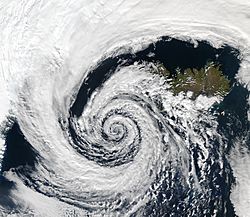Pressure system facts for kids
A pressure system is an area in the Earth's air where the air pressure is either much higher or much lower than usual. These systems are always forming and disappearing. They are created by how air and water interact in the atmosphere, oceans, lakes, and other water bodies.
Contents
Pressure Systems on Weather Maps
On weather maps, which show weather patterns, low-pressure systems are marked with a big red L. However, if they are tropical storms or tropical cyclones, different symbols are used. High-pressure systems are shown with a blue H. You can see how quickly the pressure changes by looking at how close the isobars are. Isobars are lines on the map that connect places with the same air pressure.
Low-Pressure Systems

Areas of low pressure often attract the parts that make up storms. This is why low-pressure systems are usually linked with heavy rain or snow and cloudy skies. Because of the Coriolis effect, low-pressure systems often spin. In the northern hemisphere, winds around a low-pressure system move counterclockwise. In the southern hemisphere, they move clockwise. Low-pressure systems are also often where different weather fronts meet.
Many of the strongest storms in history, like the 1993 North American storm and all tropical cyclones, have been low-pressure systems that spin. Tornadoes always have very strong, local low-pressure systems right at their center, called a vortex.
High-Pressure Systems
High-pressure systems usually bring clear, cool weather. Around high-pressure systems, winds flow in the opposite direction of a cyclone. This means they move clockwise in the northern hemisphere and counterclockwise in the southern hemisphere.
In the northern winter, high-pressure systems often move into middle-latitude areas. These are sometimes called Canadian highs or arctic air masses. They can cause cold snaps where the weather becomes unusually cold and sunny. These cold snaps can happen suddenly. They often follow warmer winter periods.
Arctic highs usually do not cause rain or snow by themselves because they bring clear skies. However, when they combine with other weather systems, the cold air they bring can lead to huge snowstorms.
Images for kids




